How To Create A Deep Link To An App
Introduction
Deep links have a storied history as an essential element of attribution. In early 2015, the term and its associated technology barely made sense to even the most savvy technical marketer.
Today, it's a ubiquitous element of every marketer's jargon and attribution stack.
But while many recognize the overall importance of deep linking to the mobile user experience and high-performance paid marketing, few truly understand how things work and how deep linking can be leveraged to drive results.
This should come as no surprise since deep linking has become more complex and confusing with the advent of Apple Universal Links and Android App Links.
But it doesn't have to be confusing; the goal of this guide to provide you with everything you need for understanding about deep linking, recognizing its value to your business, and learning how to employ it in your attribution strategy.

Chapter 1
Deep links are just links
The basics
What is a deep link?
Well, many people may not be familiar with the term, but they do know what links are.
You can't understand deep links if you don't understand links.
We use links for many things: to drive users to product pages, to execute paid campaigns on Facebook, to route users to an app store from web and email, and even to communicate important offers and deals in the app.
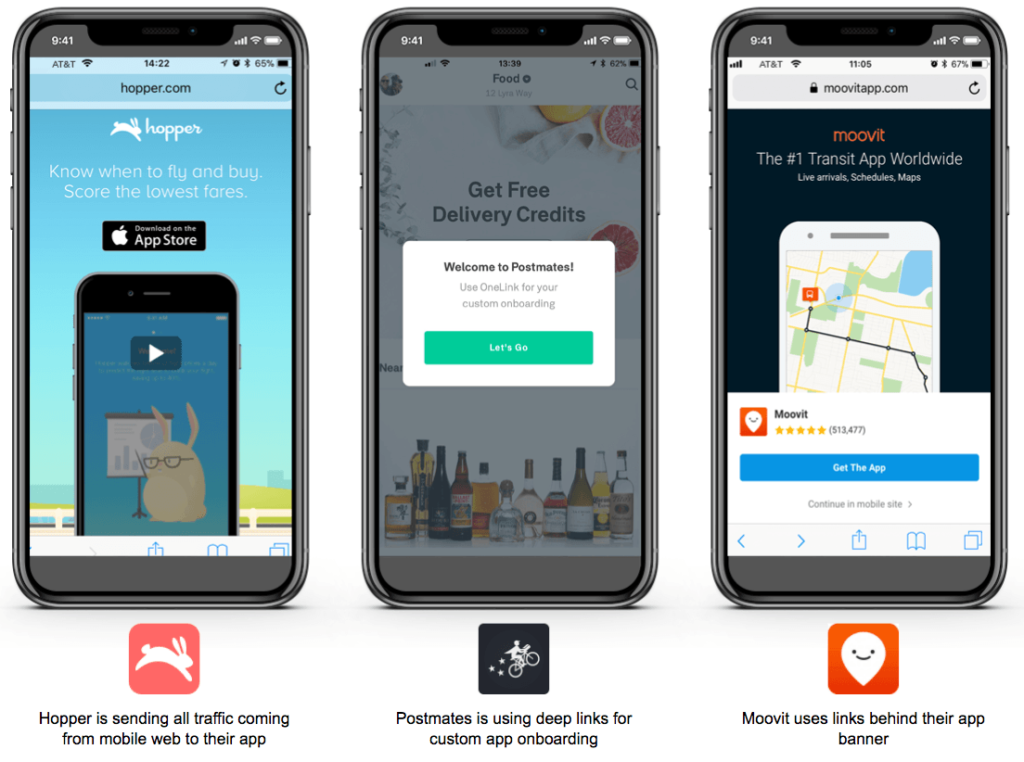
Links are used by apps, big and small, to drive users to the proper destination on the web and, of course, in the app.
So, then, what is a link?
A link is sometimes referred to as a URL or URI (Uniform Resource Locator / Identifier).
A link is merely an address, name, or reference to a file on "The internet"!
You can think of a link as a specific address on a specific street in a specific zip code.
When you type 'https://www.walmart.com', you're working in the same mental model as if you are looking for an actual address in the physical world.
Where this analogy diverges is that a link, or URL, refers not to a house with an address, but to a file with a digital address.
This address is the URL.
Most URLs refer to a file on a computer or machine on a network that exists in the world. Just as we know addresses reference a house, office, or residence somewhere in the world, digital addresses – links – do the same thing with files and resources on the internet.
Links, or URLs, can refer to many types of resources, just as physical addresses can refer to many types of structures, like apartments, malls, offices, government buildings and more. URLs can be files (like an HTML page), databases, APIs, and much more.
A Link is a URL, and a URL is a URI
This is hopefully where the dots will start to connect.
In mobile, the term "URI" is flung around often, but most folks don't know what this is or how it relates to everyday links.
In programming, a URI (Uniform Resource Identifier) is just a string of characters to identify the name of a resource on a network.
A URI is just another address in the world.
But the most common URI out there is the URL, a Uniform Resource Locator, which we have discussed at length.
URIs are not just limited to this so when you hear "URI scheme" or "URI" you should know that people are actually just talking about garden variety links, the same type you likely use in email campaigns, affiliate promotions, and on social media to promote products or your app.
Let's put our knowledge into practice and look at a link:
Example Link
'https://www.walmart.com'
This is a URL or "link". It has two main components, separated by a colon.
Protocol Identifier (Scheme)
'https' – this is the protocol identifier or the scheme.
Resource Name
'www.walmart.com' – this entire string is called the "Resource Name." It includes the subdomain, domain, and top level domain (in that order) combined into a single string. While not explicitly seen here, everything after the final slash "/" is called the "path" or "pathname". If the URL is an address, then the pathname is the actual room in the house or building that the URL refers to!
If we think back to our physical address analogy, the scheme identifier most accurately embodies the mail carrier you use to send mail to the address. There's UPS, Fedex, DHL, USPS and other options. Similarly, in the digital world, there are many types of schemes over which to send data, like accessing a website, downloading a file, or even sending digital mail. Other schemes include File Transfer Protocol (ftp), Gopher (gopher), File (file), and News (news).
HTTP stands for Hyper Text Transfer Protocol (HTTP), which is typically used to serve hypertext documents. The "S" in HTTPS is just the secure version of HTTP – it actually just stands for "Secure." The HTTP and HTTPS protocols are typically used to send data between your browser and the website address you're accessing.
Links as addresses
Here's a comparison of a real life address to a digital address, and how the components of each are related.
As you can see, just like a physical address, a link has similar identifying features. Understanding how links are structured is the basis of understanding what deep links are and how they behave in a variety of situations.
| What it's Called | Real Life Address | Digital Address | What it's Called |
|---|---|---|---|
| Complete Mailing Address | Facebook 1 Hacker Way, Suite 1 Menlo Park, CA 94025 | https://www.facebook.com/zuck | Complete Digital Address (Link or URL) |
| Recipient Line | Subdomain | ||
| Delivery Address | Menlo Park, CA 94025 | www | Domain |
| Country | United States | .com | Top Level Domain |
| Carrier/Mail Delivery | UPS, Fedex, USPS | HTTP, FTP, fb:// | Protocol Identifier or Scheme |
| Building & Office, Apartment, Suite etc. | 1 Hacker Way Suite 1 | zuck | Path |
Here's what to take away from the above table:
- A link is just a digital address. An address is to a map as a link is to the internet.
- A link is a URL. A URL is a type of URI. These things have fancy names, but at their core serve the same purpose and mean similar things.
- A URL is made up of a "Scheme" and a "Resource Name." The "Resource Name" has four important components:
- Subdomain
- Domain
- Top Level Domain
- Path
- Deep links are very specific URLs, just like specific websites or physical addresses.
The mobile context: URI schemes=App PO boxes
Deep linking starts and ends with URLs, or URIs.
Just as we discussed before, a link and a URL are one and the same.
At a very high level a deep link is a link, or a special URL that routes to a specific spot, whether that's on a website or in an app. These particular spots are deep links.
These might not be publicly visible to the world, but they exist as a real place to reference.
Key Point: The term "deep link" has come to mean the routes to specific spots on websites and to a native application via a link. A version of the term, called a "mobile deep link," is a link that contains all the information needed to take a user directly into an app or a particular location within an app instead of just launching the app's home page.
Deep links on the web are no different than deep links for apps – in both cases, links conceptually function the same.
The only difference is the way they look and behave. Most often people interchange the term URI or "URI Scheme" with a deep link. This is not only technically incorrect, but creates confusion.
The proper way to think about deep links is as follows:
- There are many types of deep links – including deep links that go to websites and to the app
- A deep link is just a link, which is a URL
- URLs can be deep links
Here is where things all come together: Remember the thing we talked about before, "schemes"?
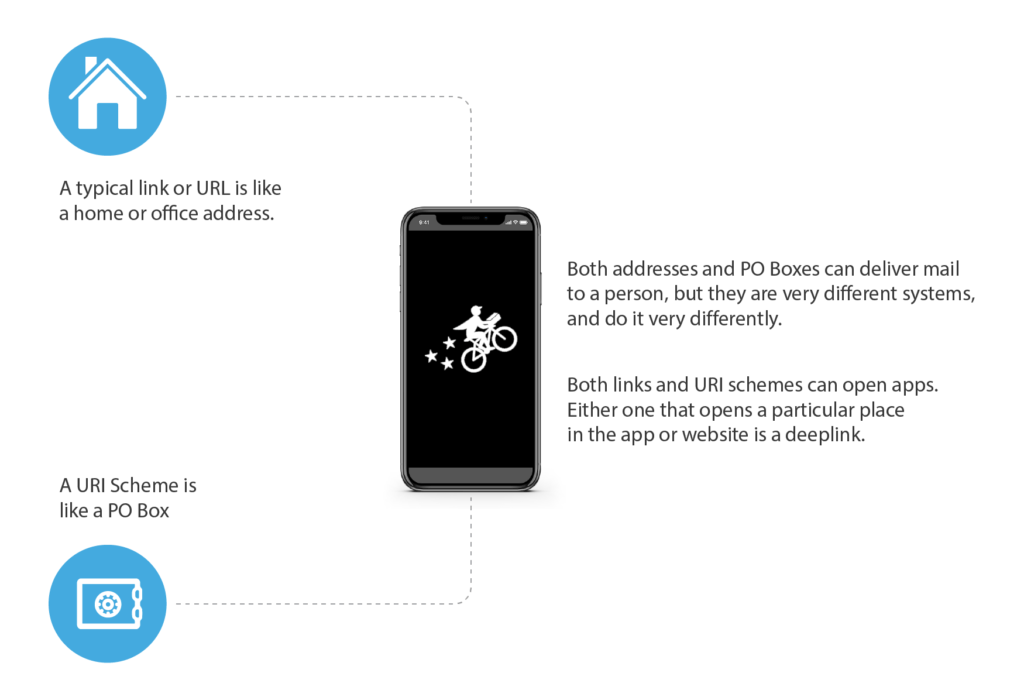
An app can have its own special way of opening via a customized, registered scheme.
This is called the app's "URI Scheme". You can think of a "URI Scheme" like PO Boxes.
You can send mail to PO Boxes, but some differences and restrictions apply.
They don't behave the same as regular mailing addresses. Each app has its own URI scheme that is registered to the app with the app stores and which is specially designed just to open that app.
| Deep link? | Link examples | Description |
|---|---|---|
| No | https://nytimes.com | This is a link that goes to a "top level domain" page. This is not a deep link because it doesn't go anywhere deeper within the domain. |
| Yes | https://www.hbe.io/about | This is a deep link because it goes to a place deeper within the website than just the main splash page. |
| Yes (Kind of) | nytimes:// | This is the iOS URI Scheme to launch Times' mobile app. People often interchange this with the term "deep link" which is incorrect. The correct thinking is that this URI Scheme can deep link a user into the app in certain contexts. |
| Yes | nytimes://ip/Trump-Korea-Tensions/172218418 | This is a deep link. It is the iOS URI Scheme to launch the Times' mobile app followed by the "route" to deep link a user to this particular item. |
Key takeaways
- A URI Scheme is a way to directly open the app if it is installed on the device – this is the same as being able to send mail to a very specific Box if you have a PO Box number. The PO Box system is regulated by USPS, just like URI Schemes are regulated by the app engineers and the app stores.
- The term "deep links" is often incorrectly interchanged with an app's URI Scheme. A URI Scheme with a specific path (`nytimes://ip/Trump-Korea-Tensions/172218418`) is a deep link.
- All of these are deep links:
- https://www.facebook.com/zuck
- fb://zuck
- nytimes://ip/Trump-Korea-Tensions/172218418

Chapter 2
Making sense of universal links
Marketing and product teams are often confused by the concept of Apple Universal Links (iOS) and Android App Links (Android) and how they relate to deep linking.
What is not well-explained is the fact that these links are not really different "links" at all, but rather are behaviors or mechanisms applied to certain links that control how a user navigates to the app.
Similarly, the two different names refer to essentially the same concept, but are often interchanged, or confused with other routing mechanisms. It's important to be explicit when you talk about these concepts, else you risk confusing or confounding different technologies which operate very differently.
Specifically, Apple Universal Links are a standard from Apple that is deployed on the iPhone operating system (iOS), which allows a user to tap a link and be delivered immediately to the app (if it's installed on their device).
Apple Universal Links are neither new, different, or special links, nor are they link redirects.
They function as part of a complex system setup that changes the behavior of regular old links, turning them into app deep links in certain contexts. When the user taps the link, a roundtrip server call is made to Apple and the OS opens the app immediately without ever opening the browser or loading the URL. More about how this works below.
Android App Links is the equivalent linking system that is setup on Android.
How universal links and app links work
For the purpose of explanation, let's talk about how these two systems work from the perspective of the Skyscanner app. Generically, an Apple Universal Link or Android App Link is any link that, when tapped, takes the user directly to the app.
Most marketers and product managers are accustomed to seeing redirects, where a link goes to a browser before ultimately sending the user to a final destination.
Apple Universal Links and Android App Links are not redirects – they are actually a special technology applied to links that sends users directly to the app.
When you download an app that has Universal Links or App Links enabled on its links, you are also downloading a special file. On iOS this is called the Apple App Site Association file. On Android it's called the Assetlinks file.
Both of these files are hosted on the actual website of the links in question and both these files contain a type of map of where to send the user when they tap the link in the future. Coupled with these files is a small code change that allows the app to take the user to the right spot.
Try it out and see for yourself what the technology looks like.
Just visit the domain, followed by apple-app-site-association: https://www.skyscanner.co.il/apple-app-site-association
And just as normal skyscanner.com links can be Apple Universal Links, so too can skyscanner.com's attribution links. Herein lies a nugget of important information: Android App Links and Apple Universal Links is a system that is applied to all types of links – including the links for a company's website as well as the links they use in attribution and deep linking.
As mentioned before, third parties like AppsFlyer can also leverage the concept of Apple Universal Links and Android App Links on their customers' behalf so that these attribution links take users to the app if they have it. The result is that users have a better experience across paid and non-paid channels.
The relationship between Universal Links, App Links and your attribution links can be confusing and is lost on even some of the most technical marketing teams.
The correct, technically accurate way to consider things is that your attribution and deep linking provider, such as OneLink, supports Apple Universal Links. It supports this Apple-developed mechanism that allows the app to open on iOS 9.3+.
In other words, Apple Universal Links is a standard that can be applied to any link, and the best attribution and deep linking vendors support this standard.
Known problems with Apple Universal Links
Apple Universal Links is a useful technology that is proven to offer a better UX for users who have the app.
However, these links have a few important limitations to be aware of else you and your product teams will be spending endless hours debugging issues that cannot be fixed. There are actually four core issues as of the writing of this document (iOS 11). They almost all only applicable to Apple Universal Links, not Android App Links.
Issue 1: No measurement or attribution
Because Apple Universal Links are not a redirect, but rather a system applied to links to open the app, it is very difficult to establish true click measurement.
Why? Because the app opens immediately from Apple Universal Links.
There's no redirect through a webpage to count a click to a server. Instead, when the app opens, the URL that opens the app gets reported in via a well known Apple code snippet called 'continueUserActivity'.
To count a click on the URL, a marketing team would have to setup a server and manually count the click from the app.
A much simpler and easier solution is to use an attribution and deep linking tool. These systems enable marketers to leverage Universal Links and automatically execute this type of measurement for you. In short, whenever you need to measure users who click on links, you should use a third party tool, such as OneLink.
Issue 2: No link wrapping allowed
This problem goes by many names – link wrapping, click measurement, link redirect – they all refer to the same thing.
When a marketer runs an ad or sends an email, often the service they are using will take the link they are using and "wrap it" or send it through a redirect so that the system they are using can count a click. It does this by redirecting to their website before sending the user to the final destination URL that the marketer input into the system.
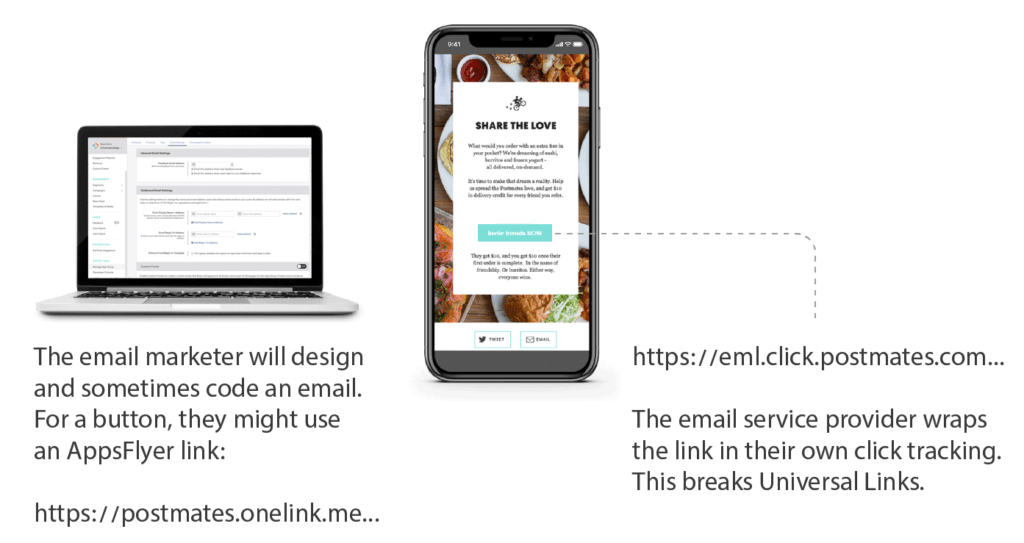
Both Apple Universal Links and Android App Links cannot be wrapped in other URLs.
If you do this, the link will redirect users to the web fallback instead of to the app.
This mostly impacts marketers running paid ads with services like Double Click (where URLs get wrapped) and email marketers who have click measurement enabled with their email service provider (ESP).
In both cases, other third party tools may wrap URLs you are using that would otherwise behave as Universal Links. This breaks the functionality and defeats the purpose of using Universal Links. There are a variety of solutions to this, from turning off click measurement to employing a specialty consultant to help navigate the complexity.
Get the latest marketing news and expert insights delivered to your inbox
For some reason, Apple may randomly inject a banner ad onto your site in Safari when Universal Links are implemented.
There is no way to control this, customize it, or measure it. It's a strange feature that Apple introduced with Universal Links and has confused the market quite a bit.
Most customers just choose to ignore this, as it is only displayed in a few cases, while a click on Apple Universal Links would normally take the user to your app and not your website.
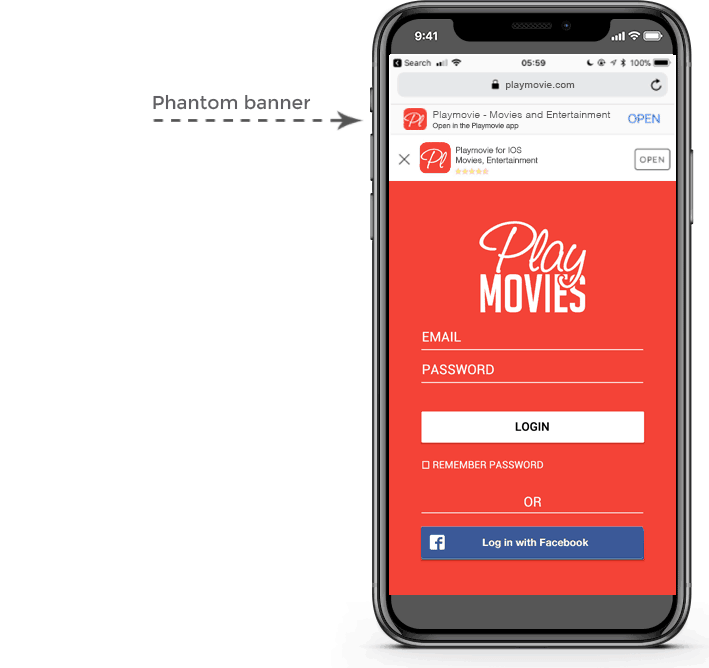
Issue 4: General performance instability
Starting with iOS 11, many app developers have noticed that Universal Links do not always perform the same way.
Assuming you've set up Universal Links on your regular URLs or on the URLs you use for your attribution provider, you can test this by doing the following:
- Log out of app
- Delete app
- Install the app from the App Store or test/QA site
- Restart the device (turn off and then on again) – on iOS 11 this can often fix strange entitlement issues where the behavior of the link is not correct when clicked
- Create or find a link you are trying to test
- Paste the link in Notes, iMessage or in an email using the Apple Mail Client
- Do not use Slack, Facebook or any other app to click the link
- Do not paste the link into Safari – this will not work correctly
- Click the link
- The app should open immediately, without a redirect through the browser, and route the user to the proper place in the app
The following illustration will make sense of it all:
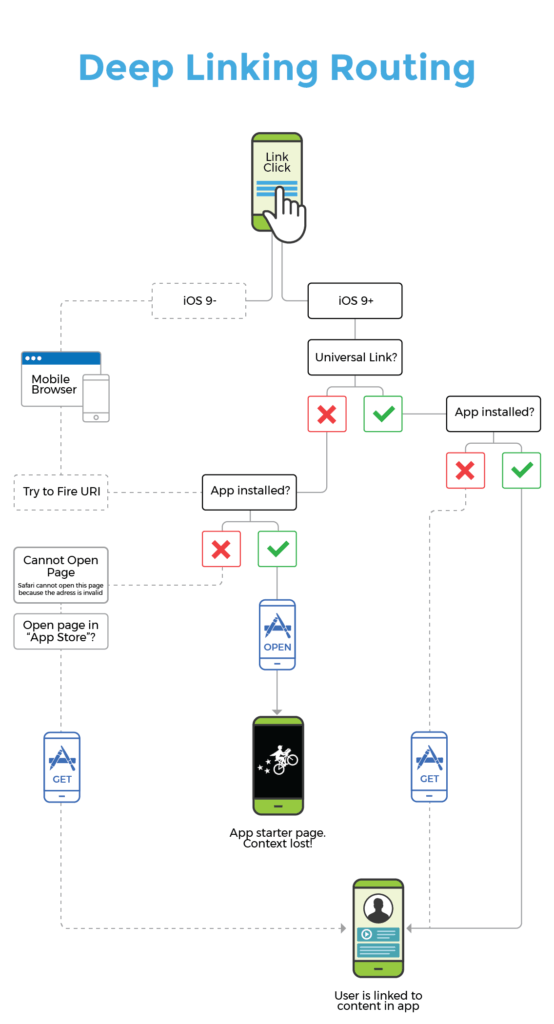
Key takeaways
Both Apple Universal Links and Android App Links are fairly complex technical systems.
They do not describe special links, but rather refer to a unique and advanced system of routing users, leading to many pitfalls and issues to deal with.
The key takeaways about both these technologies are the following:
- It's a system applied to links that controls their behavior.
- Both systems allow users with the app to click a link and be immediately routed to the app (without any redirects).
- It makes regular web links into app deep links, but the technology can also be applied to third party vendor links, like offerings from attribution vendors such as AppsFlyer. In this case, your attribution links can open the app immediately, allowing for a better UX and higher performance when running retargeting and other types of re-engagement campaigns.
- There are many known issues that even marketers must know how to properly test links in order to avoid confusion when running ads that deep link users into the app.

Chapter 3
Why deferred deep linking is a game changer
Why don't regular links that open websites, also open apps?
You don't have to do anything special to visit Mark Zuckerberg's Facebook page ('https://www.facebook.com/zuck').
You just type his website address into the browser and the page loads. This is why you almost never hear the term "deep linking" in reference to websites, but rather in reference to native apps.
It's because apps don't behave like browsers.
They can't receive mail in the same way that your house or office receives mail. They behave like PO Boxes. Apps have to be configured correctly and specifically for each app – or by comparison, they require their PO Box to be registered in order to be opened by a user directly via a URI scheme.
The technology that solves this problem is called deferred deep linking.
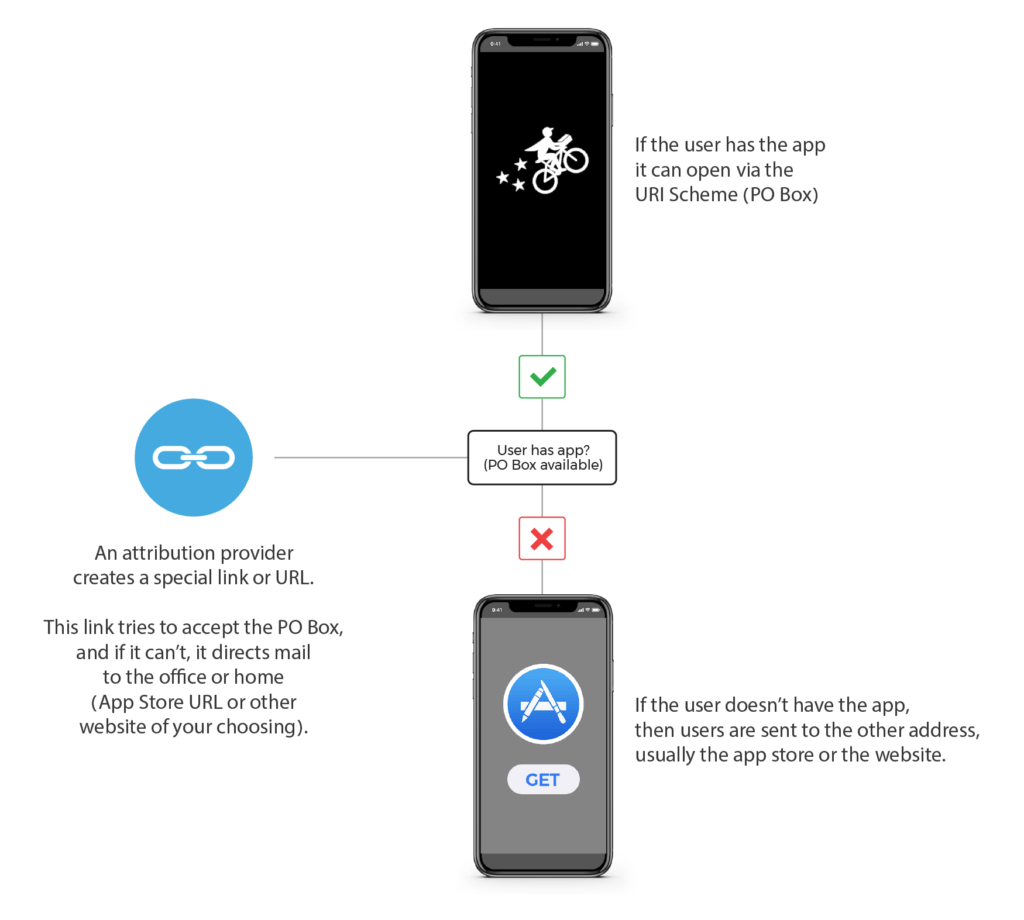
What is deferred deep linking?
It's a concept invented by the deep linking industry in 2014. It refers to the process of deep linking a user after they install an app for the first time.
If a user can't access the PO Box, they can install the app and access it after.
Deferred deep linking ensures that after they install, the user gets to the right spot in the app. Deep linking providers can defer or delay the deep linking process until after the app has been downloaded.
How deferred deep linking works
The attribution provider would create a special link or URL which:
- Tries to open the PO Box (URI Scheme). If it works then the user goes right into the app
- If the PO Box can't be reached (URI Scheme doesn't work) it means the user doesn't have the app, so instead it delivers the user to the App Store or Website – you can think of this as the home or office address.
- After the user installs the app, the attribution provider can send the mail to the PO Box (to the app) after the user opens from an install, allowing the user to continue their user experience.

Example deep link:
https://walmart.onelink.me/UIev?pid=Test&c=Test&af_dp=walmart%3A%2F%2Fip%2F33982751&af_web_dp=https%3A%2F%2Fwww.walmart.com%2Fip%2FIAMS-PROACTIVE-HEALTH-Adult-MiniChunks-Dry-Dog-Food-40-Pounds%2F33982751
In this case, the URL is an AppsFlyer link.
It behaves as a deep link because it tries to open Walmart's URI Scheme, and if not, it falls back to the App Store.
- URI Scheme: walmart://
- Deep link path: af_dp
The importance of deferred deep linking
Previously, the only way to integrate deep linking was through heavy lifting across all mobile platforms a developer supports (App Store, Play Store, Windows etc.).
This was a huge barrier to entry for small developers hoping to create an easy way for all users to access their app.
Another big problem with deep linking is that it could not carry data through the app install process. Or, in other words, if the PO Box wasn't setup then a user couldn't get mail!
Without a URI scheme, there was no reliable way to deliver the user to the app, even when they didn't have it installed. Deep links don't provide context about the user unless they have the app already installed on their device.
- Optimal Conversion: For e-commerce and other brands that sell products or services in their app, only deep links allow you to drive users straight to the point of sale, even after install
- Better User Experience: Users can go to the app store or app and get driven to a particular spot in the app after the install
- Personalization: Deep links allow user information to carry through the install process, which enables apps to deliver a custom welcome message or personalize the first experience in other ways
For technical minds, deep links and attribution vendors also provide a slew of benefits:
- Data reliability: All your data can be consolidated by device and user identity, making it easy for you to export data to a downstream source or visualize in a vendor dashboard
- Deferred deep linking: Better ads, better customer experience and improved conversion
- Efficiency: Save money by not spending on ad sources that are leading to high uninstall rates
- Analytics: Measure more metrics via an integration with a CDP like mParticle that ties all data sources together in a single spot
- This matters a lot when over 60% of users drop off less than 24 hours after download, you've just provided the user's first experience migrating to the native app as an error message.
More importantly, according to AppsFlyer data:
- Deep linking users from your paid attribution sources drives a 31% retention to the app
- Users convert at a 2.5x higher rate when they come from a deep link compared to a regular attribution link
- Deep links have higher intent, which means a much higher lift in revenue. In fact, industry reports show that deep linking provides a 148% lift in average revenue per user (ARPU)
- Users who click on a deferred or regular deep link such as AppsFlyer's OneLink are 2X more likely to spend money in your app and will spend 2.7X more dollars on average
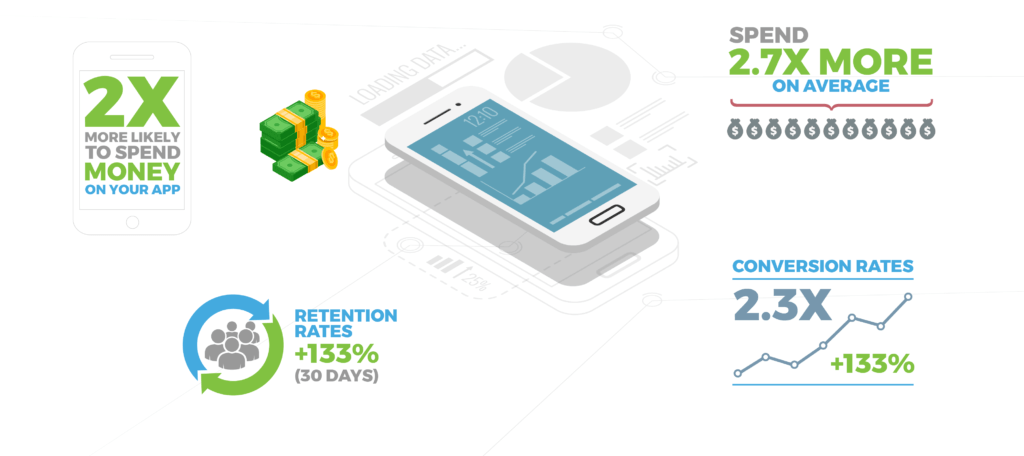
Key takeaways
- Web links can't open apps like URI schemes can
- Using an attribution or deep linking vendor provides many benefits:
- Optimal Conversion
- Better user experience
- Personalization

Chapter 4
Use cases: How to leverage deep links to drive better performance
We have established that deep linking is a feature of Attribution which drives a better user experience across different channels, and creates better performance from these channels.
This is especially relevant in cases where the number of steps to conversion dictates performance success. Leveraging deep links to drive users to the optimal place in the app as quickly as possible, and with the right context, can unlock a higher performance across paid and non-paid channels.
But what does "leveraging deep links" look like?
This is another common issue in the industry.
Many vendors talk about the value of deep linking without showcasing specifics. To try to combat this problem, below, we will explore how typical customers leverage an attribution and deep linking service in order to drive better UX and performance from paid and organic channels.
How does an eCommerce app think about use cases?
Let's explore:
- Running mobile app download campaigns with Google, Facebook, Pinterest, Snapchat, etc.
- Deep link users to specific products, even through the install process across all these channels
- Create single URLs that can drive and measure installs or opens for all marketing org efforts
- Analyze performance of "Download the App" banner at the top of mobile Web page and in emails
- Send a live feed of app downloads to ad partners to create a real-time blacklist (don't show ads to customers who already have the app)
- Show customers a dynamic "Easy Reorder" ad featuring products they've purchased before with a link to download the app and opening the Easy Reorder page upon app launch
But use cases don't stop there.
You can leverage an attribution and deep linking solution to power a variety of use cases, all of which have had noticeable growth impacts and can help serve a mobile marketing team.
Deep linking use cases
Social
This is one of the most common use cases for leveraging mobile links.
In this example, a marketer or mobile app would place a link to content in the app on a well-known social channel, such as Facebook, Google, Twitter, Instagram, or Snapchat.
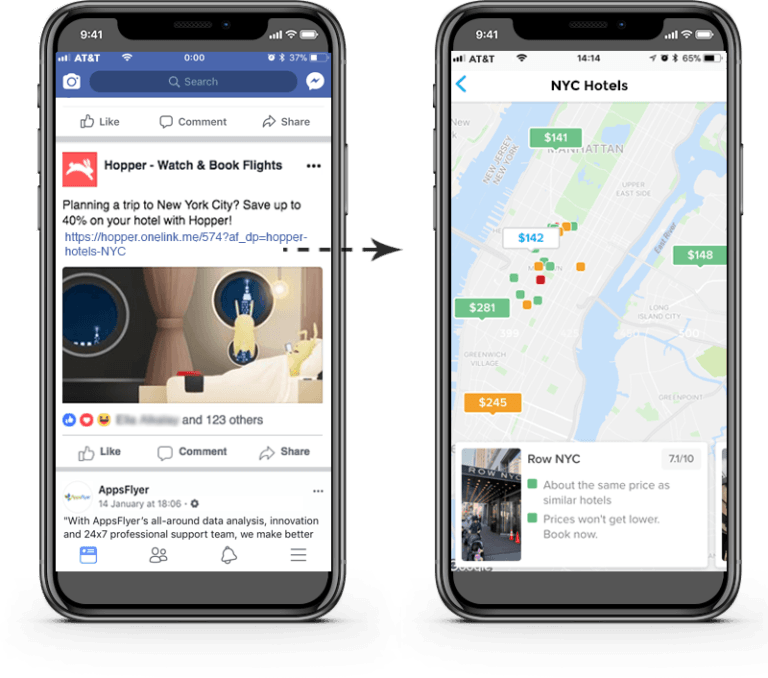
With a universal routing and attribution system, this single URL would be able to intelligently route the user to the app store if the user did not have the app, or open the app via Universal Links & Android App Links if they did.
Beyond this, there are solutions that have a built in feature that scrapes "Open Graph" information from the URL.
This means that the attribution link will display a preview of the content, title and description when the link is posted in social media. Similarly, this option allows the link to be shortened, conserving space in posts and providing a level of trust in the link the user is clicking.
Email is another great medium to leverage attribution and deep links.
Traditional email service providers (ESPs) do allow you to measure clicks on links, but they don't always have the ability to route the user to the app store or app intelligently.
Also, Universal Links usually break if you wrap click analysis around them.
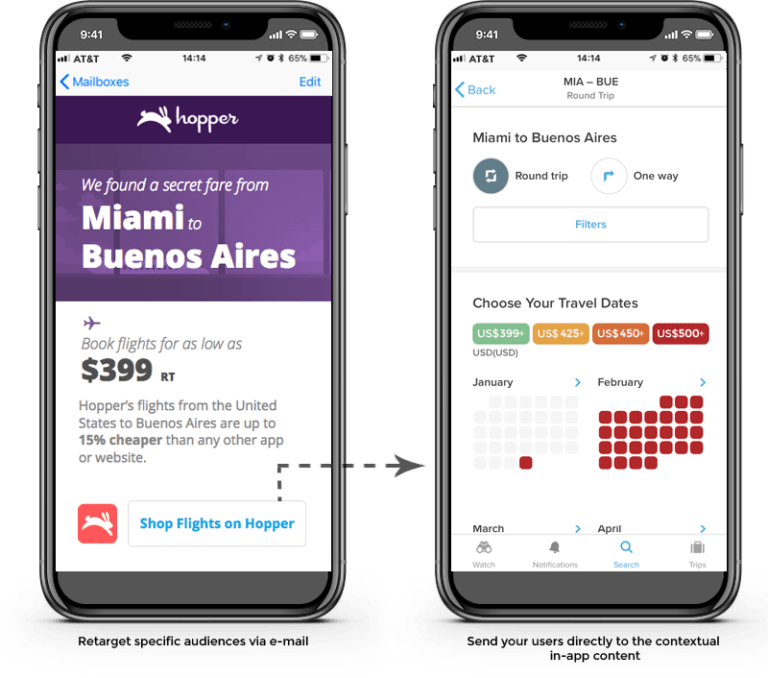
An email marketer can create deep link urls programmatically or manually and place them in the email for a better user experience.
SMS and referrals
Everyone knows that word of mouth referrals provides one of the strongest mechanisms to spread the app and create virality. Text message and SMS is the digital equivalent of this whereby friends can share great new apps with their friends.
Advanced deep linking technologies enable marketers to dynamically create short URLs in the app to share the app or a referral program.
This is how it works:
- A user would share a link to the app from a piece of content or referral screen in the app.
- At the moment when the user hits share, you can leverage the deep linking API to create a short link and stuff it with useful data that you want to tie to the user – such as promo codes, content strings, or even the referrer's name and user ID.
- When the user then shares it on SMS that data will all be wrapped up in a short link.
- When the receiving user clicks the link, they get an optimal experience – going to the app store if they don't have the app, and to the app if they do.
- After downloading, your app developers will get all this rich data back in the app to help understand and invest in your best virality loops and referral channels.

QR codes
While some scoff at the use of QR codes, they serve as a major channel for many companies outside of the US.
With an attribution and deep linking provider can you create a url and instantly generate a QR code.
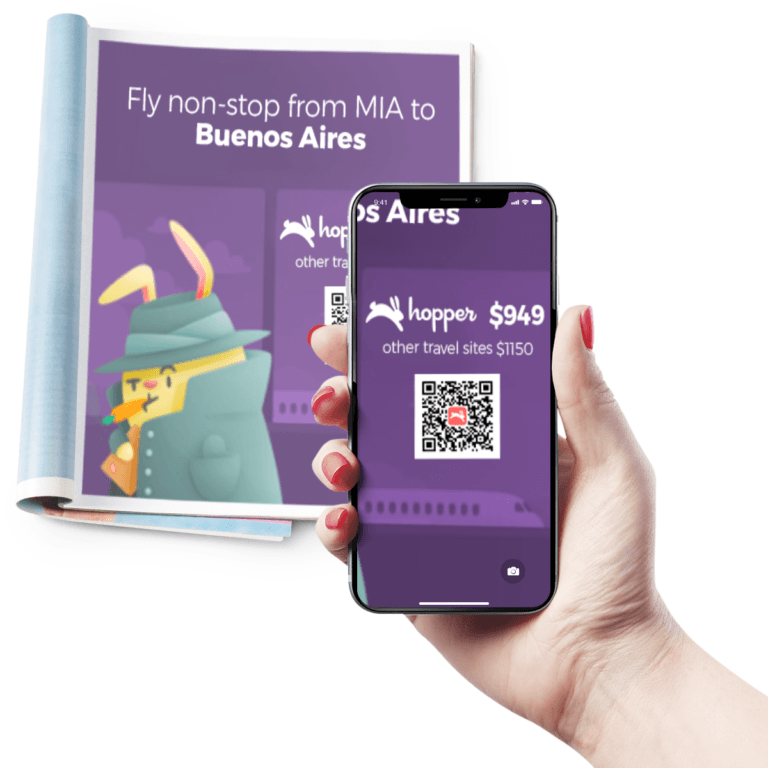
These codes, generated in the dashboard, can then be placed in emails, SMS, direct to consumer marketing and other mainstream channels.
With Android, QR codes can be instantly scanned and in iOS 11 there's a built-in QR reader in the "Passes App."
Get the latest marketing news and expert insights delivered to your inbox
Custom onboarding
An advanced version of SMS sharing and referrals allows you to use the data you share in links to provide a welcome screen or customized onboarding.
The concept is simple: when you create links for users in your regular marketing channels or even in SMS and referral links, you can include information like a "popup title" or "popup message", and then display this information in the form of a welcome message.
Postmates uses a deep link to display welcome messages to users who come from paid and organic.
Example link:
https://postmates.onelink.me/5uYG?pid=facebook&af_click_lookback=7d&af_dp=postmates://root&promo_code=icecream&title=Welcome%20to%20Postmates!&message=Use%20OneLink%20for%20your%20custom%20onboarding&button_title=Let%27s%20Go
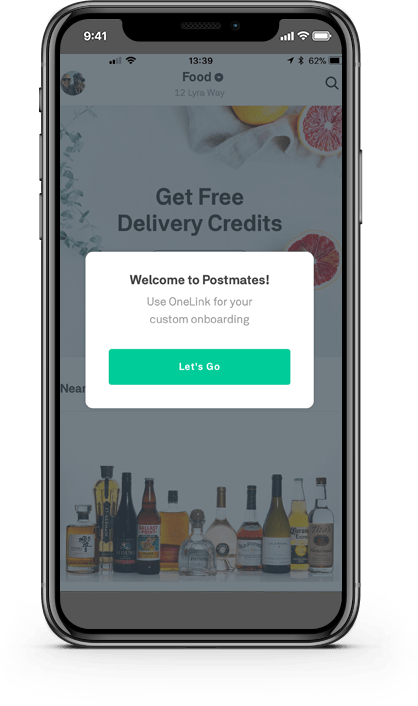
Web-to-app banners
Last, and certainly not least, one of the most well known use of deep links is to drive users dynamically from your mobile web site to your app.
Because most deep link provider URLs are easy to structure, many mobile teams develop their own banners or use one of the many templates AppsFlyer provides for free.
Your team can customize the banner however you'd like and then, an advanced deep link can power the urls and attribution behind the button.
In the below example, Moovit uses their own customized banner alongside AppsFlyer's OneLink technology so that users can click and download or navigate to the app from moovitapp.com.
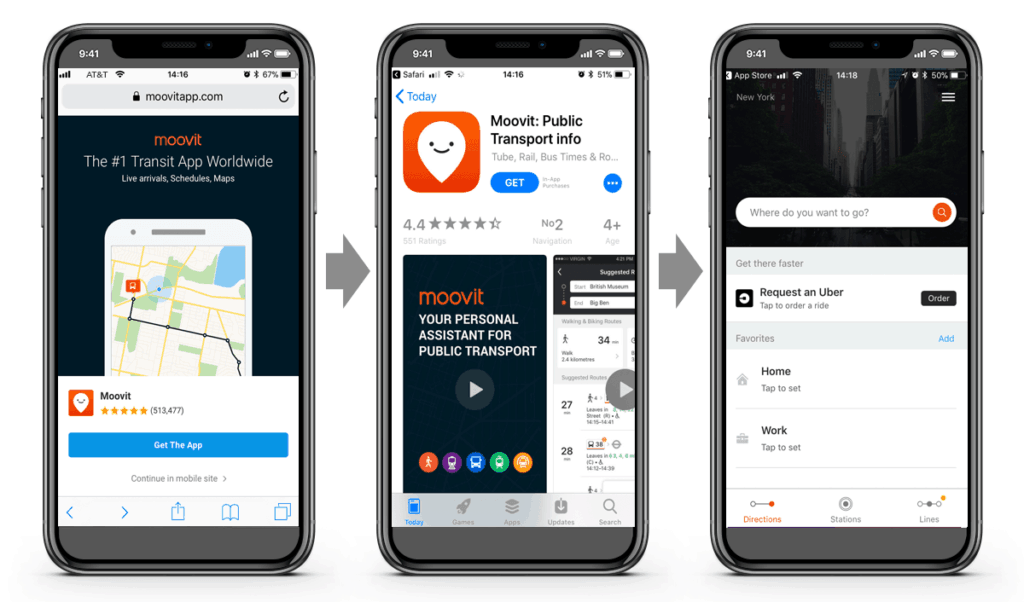
Regardless of whether the user has the app, an advanced deep link can direct them to the appropriate content, even after installing for the first time.

Chapter 5
Why combining attribution & deep linking is key to mobile success
While often misconstrued as separate technologies, attribution is what allows for deep linking.
It's important to know this and why you should pick one vendor to do both.
Deep linking is a consequence of attribution
As we all know by now, a deep link is just another URL or link that has some special properties. How app developers use these special properties is what most people refer to as "deep linking." When your app deep links a user, the app actually first attributes the user.
For example, when a user clicks an ad or link, the browser takes some identifying information about the device so it can properly "recognize" the user later. Then, the link redirects the user to the app store where they can install and open the app. At that moment in time when the user opens the app, all attribution and deep linking vendors are the exact same.
The user is matched with a Google Play Referrer (if on Android) or the same information gathered from before they installed the app – usually a combination of a device's IP, Phone Size, Screen Size, OS, OS Version – and then the vendor, like OneLink, responds to the app with attribution data, such as the campaign the user came from, the media source and the URL.
Regardless of attribution mechanism, the attribution & deep linking vendor provides a "callback" or a server response telling the app where the person came from – what Facebook campaign, Google Ad, etc.
For example, if a user clicked and install from an ad, the app would receive something like this:
{ c:test pid:snapchat … other data … referring_url: https://xxx.onelink.me/abc?c=..&pid=&af_dp=URISCHEME://PATHWAY } In this response to the app, the 3rd party can also tell the app which URL the user came from.
This is usually called the referral source, or the URL that referred the user to install; the app looks at this piece of data to route the user.
Deep linking is the process of using attribution data to route the user appropriately.
AppsFlyer does this with the URL af_dp value, which is sent in the attribution callback when the app opens and reports an install or open.
The key point here is that deep linking is just using the attribution data to route the user.
It's super important to know this and is the basis of why you should never use two vendors for attribution and deep linking.
It's all the exact same technology.
There's no point in doing deep linking with one company and attribution with another when the technology is the same and you can get the exact benefits using one tool.
Benefits of using one tool for attribution and deep linking:
- Tool and SDK reduction – You don't need two tools to do the same thing. This reduces size of the app, and helps marketing teams operate more efficiently since they don't need to go back and forth between two different systems
- Reduces tech debt – it's easier to maintain one SDK and its codebase versus two
- Deep link off of all your channels – you can use the tool you leverage for attribution to drive users to specific spots in the app
- Consistency in reporting – because all attribution and click data from deep links flows into one dashboard, it's much easier to analyze data and pipe this information to a customer data platform such as mParticle
- Cost – one tool is cheaper than two!
Attribution and deep linking are central to the enterprise mobile growth stack
When we talk about the mobile growth stack today, we are really talking about 6 key components:
- Attribution and deep linking
- Media and ad networks
- Marketing cloud
- Marketing automation
- App Store intelligence
- Product analytics
Attribution with deep linking provides an important place in the growth stack. In fact, attribution and deep linking are one of the core pillars that growth teams can rely on to execute against KPIs. They are among the first components setup after the customer data platform because their utility and value can be proven almost immediately:
You can't run good performance marketing without understanding the source of your growth and ensuring customers are getting a world class first impression of your app via deep linking.
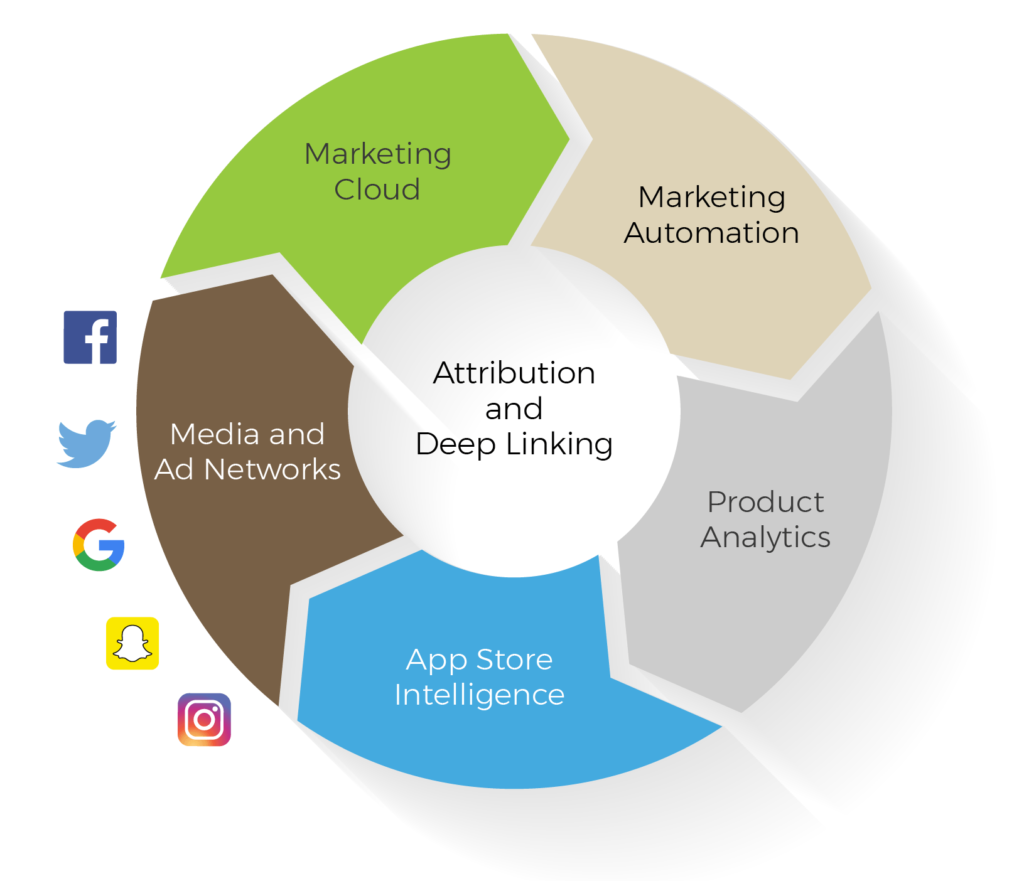
This toolset is tightly connected to the customer data platform and serves as a two-way sync of data tied to device and customer data, allowing growth teams to understand how they are acquiring users as well as what actions they take downstream in the app.
All of these platforms provide mobile app attribution and measurement technology that is at the hub for a company's mobile app download and re-engagement campaigns.
They enable measurement of the ROI of app download campaigns, provide a single source of truth for metrics such as Cost per Download and Cost per Consumables Customer Acquisition, and create a single system for deep linking across all channels.
Why is it important to invest in a tech stack?
The tech stack you build and maintain within your mobile marketing and product teams will define your success on mobile. That's because each piece of the stack serves a specific purpose, and trying to get by without certain components will almost always catch up with you.
The best teams in mobile think not just about their short term needs – such as setting up solid attribution – but also how their needs will evolve and how they can tie tools together to serve future purposes.
It's important to invest in multiple best-in-class tools that compliment one another in order to be efficient in mobile marketing. It's also important to avoid duplicative features, to remove bad and old tech just as much as you add new technology, and to setup your stack right from the onset.
Growth stack best practices
If you know that a growth stack is important then understanding its ideal characteristics is important in your vetting & implementation process.
As you set out to design and implement a stack that includes attribution and deep linking, consider some of the following best practices from HBE Ventures, a US-based mobile growth consultancy firm:
- If Facebook is an important paid media channel, picking an attribution provider that is an MMP is a non-starter. Vendors without access to this program will provide a less accurate reporting from this channel
- In early 2014, deep linking was a complex and novel technical innovation. It is now a commodity – all the major players offer basic to advanced deep linking capabilities.
- Optimize for deep linking providers that offer: Universal Link support, Android App Link support, short links, an API for their links and a single URL for all attribution on paid media.
- Focus on consolidating your stack. Fewer tools is better, especially in attribution & deep linking.
- Consider designing and implementing a concise campaign measurement nomenclature. A template is provided.
- Make sure you can easily sync data in and out of your attribution tool. Use a customer data platform and ensure that your attribution provider can receive downstream events and send your attribution data to the data platform for consolidating in a single visualization tool.
Key takeaways
- Deep linking is a feature of attribution – if your attribution provider offers deep linking, you do not need separate vendors for each use case
- The underlying technology powering attribution and deep linking is the same
- When vetting tools, you should first ensure that you pick a tool that meets your requirements for Attribution – this is the bottleneck. Most attribution tools also provide the ability to deep link. This should be a secondary consideration.
- There are quite a few benefits to consolidating attribution and deep linking under one roof. Marketers should take note to avoid complexity, waste, and confusion from using more than one
- Attribution and deep linking are at the very heart of the mobile growth stack
- The tech stack you build and maintain within your mobile marketing and product teams will define your success on mobile

Chapter 6
Deep linking glossary of terms
| Term | Definition |
|---|---|
| Link | A link is merely an address, name or reference to a file on "The internet"! Links are URLs, they can refer to many different types of resources. URLs can be files (like an HTML page!), databases, APIs, and much more. |
| Deep Link | A deep link is a special URL that routes to a specific spot, whether that's on a website or in an app. A "mobile deep link" then, is a link that contains all the information needed to take a user directly into an app or a particular location within an app instead of just launching the app's home page. |
| URI Scheme | A URI Scheme is a way to directly open the app if it is installed on the device — this is the same as being able to send mail to a very specific Box if you have a PO Box number. |
| Deferred deep link | This is the process of deep linking a user after they install an app for the first time. |
| Query Parameters | Query parameters are everything in a URL followed by the question mark, and each query parameter is separated by an ampersand. For example in the URL: https://postmates.onelink.me/5uYG?pid=facebook&af_click_lookback=7d&af_dp=postmates://root&promo_code=icecream&title=Welcome%20to%20Postmates!&message=Use%20OneLink%20for%20your%20custom%20onboarding&button_title=Let%27s%20Go, the first query parameter is ?pid=facebook. |
| Subdomain | A subdomain is a subset of the higher domain. For example, in the URL www.facebook.com, facebook is the subdomain of the .com top level domain. |
| Domain | This is the website. Walmart.com is a domain. So is jet.com. The subdomain is the subset of the domain. These are all links. |
| Path or Pathname | The path of a URL is essentially the final destination of a URL, the "street address" of the building where the URL leads |
| Route | The route of the URL. This is the place in the app that you can take a user to with a deep link. Every attribution and deep linking company thinks about a route differently, but universally, it is known as the string that comes after the URI scheme of an app. For example, airbnb has the following URI scheme: airbnb:// Their route for a deep link is everything after this, such as airbnb://listing/123. |
| Apple Universal Link | Apple Universal Links are a standard from Apple that is deployed on the iPhone operating system (iOS), which allows a user to tap a link and be delivered immediately to the app (if it's installed on their device). |
| Android App Link | Android App Links are deployed on the Android operating system, which allows a user to tap a link and be delivered immediately to the app (if it's installed on their device). |
| Facebook App Link | Facebook App Links are a cross-platform standard that allows a user to tap a link and be delivered immediately to the app (if its installed on their device). |
| People-Based / Multi-Touch Attribution | This is attribution across multiple devices. For example, if someone is measured taking an action on mobile web and then performs an action in iOS app, their actions can be tied together by "People-Based / Multi-Touch Attribution." |
How To Create A Deep Link To An App
Source: https://www.appsflyer.com/resources/guides/deep-linking-for-mobile-marketers/
Posted by: sailerimalk1982.blogspot.com

0 Response to "How To Create A Deep Link To An App"
Post a Comment